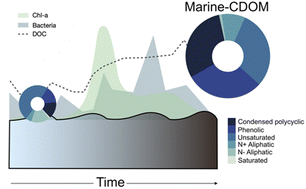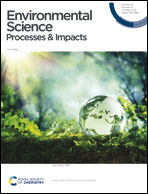Changes in light absorption and composition of chromophoric marine-dissolved organic matter across a microbial bloom†
Abstract
Marine chromophoric dissolved organic matter (m-CDOM) mediates many vital photochemical processes at the ocean's surface. Isolating m-CDOM within the chemical complexity of marine dissolved organic matter has remained an analytical challenge. The SeaSCAPE campaign, a large-scale mesocosm experiment, provided a unique opportunity to probe the in situ production of m-CDOM across phytoplankton and microbial blooms. Results from mass spectrometry coupled with UV-VIS spectroscopy reveal production of a chemodiverse set of compounds well-correlated with increases in absorbance after a bacterial bloom, indicative of autochthonous m-CDOM production. Notably, many of the absorbing compounds were found to be enriched in nitrogen, which may be essential to chromophore function. From these results, quinoids, porphyrins, flavones, and amide-like compounds were identified via structural analysis and may serve as important photosensitizers in the marine boundary layer. Overall, this study demonstrates a step forward in identifying and characterizing m-CDOM using temporal mesocosm data and integrated UV-VIS spectroscopy and mass spectrometry analyses.

- This article is part of the themed collections: Geochemistry and Best Papers 2022 – Environmental Science: Processes & Impacts


 Please wait while we load your content...
Please wait while we load your content...
